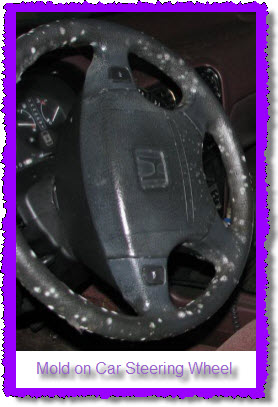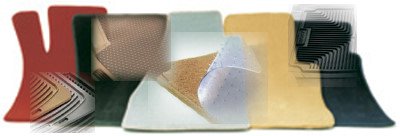Mold in Car Stinks!

You get used to mold in car smells but your passengers don't. In fact, mold in car exposure is associated with allergic reactions, asthma, and other respiratory problems.
Mold and mildew both like excessive moisture and can grow on most any surface. The key to controlling mildew and mold in car carpeting is to prevent the buildup of excess water and allow water which does get into your vehicle to be easily removed. A paper towel can be used to soak up excess water or liquid. A hair dryer may be used to dry up small wet spots in carpeting or on seats. Borax or baking soda can be rubbed into carpeting and then vacuumed out to help remove bad smells and prevent mold.
 Mold Multiplying !!!
Mold Multiplying !!!But a better idea is to prevent water and other liquids from getting into your vehicles carpeting in the first place. All weather, rubber or carpeted car mats, supplemented with a universal absorbent floormat protector helps achieve this goal. These universal absorbent floormats are easily removed and laundered. Another advantage of an absorbent floormat protector is that it absorbs the gas, oil, antifreeze and other liquids that are found on driveways, parking lots and gas stations. So mold isn't your only enemy, but it's one of the worst. So how do we detect mold in our vehicles? That's what we'll talk about next.
Mold in Car Detection
Visual Inspection and Your Nose
Visual inspection and your sense of smell are the best ways to determine if you have a mold infestation in your car. Can you see mold growing on your steering wheel, the seats or carpeting. What about the trash or old half eaten food that may be on your vehicles' floor or in the trunk? Is it growing mold? How's the inside of your vehicle and the trunk smell? You know what mold smells like, right? So go ahead and perform your inspection. By the way, there are mold test products out there but a Consumer Reports evaluation in 2006 gave them a thumbs down. In any case, whatever you decide - your eyes/smell or a test kit - you need to get rid of any mold you find. and while you're at it why not clean the entire car? Checkout my mat cleaning pages for some hints, tips and down home old fashioned recipes for getting things like mold, chewing gum, stains and other gunk outta your car mats and carpeting.
Mold Testing Kits
Mold testing kits are available at most Hardware, Home Depot, Lowes, Walmart or other home and garden stores. While the tests aren't as accurate as a visit and testing by a mold remediation company, the mold testing kit will still give you some idea of what's going on. Popular mold testing kits in the marketplace include:
Mold Armor (from W.M. Barr & Co.) $8, Optional Lab Test $40
MoldInspectionNetwork $46 includes lab analysis and consultation
MyMoldDetective $60, Lab Test Extra
First Alert Mold Detection $10, Lab Test $10 per sample
Since Consumer Reports gave home mold test kits a thumbs down in 2006 several new products have been introduced (like MyMoldDetective) and some existing products have been upgraded. Remember, nothing is as good as your eyes and nose for initially detecting a mold problem in your vehicle.
Mold in Car Remediation
Here are some simple recipes and ideas on how to get rid of mold in your car. Before you proceed wear a mask to filter mold particles and some rubber gloves to keep the moldy stuff off your hands. Try to remove any big pieces of mold with a toothbrush or vacuum cleaner. Use a vacuum cleaner or whisk broom to pick up all loose mold pieces. Then you can try one of the recipes below. Remember : Whatever recipe you try, first try it out on an inconspicuous area of your seat or carpet to make sure it doesn't have any adverse effects. Be especially careful if you attempt any of these recipes on leather items.
Recipe 1 : White vinegar, full strength or diluted, depending on how tough the mold is may be sprayed or dabbed on to the mold. Allow to sit for 1/2 hour or longer then use a wet/dry vac to suck up excess vinegar solution. Clean paper towels may then be used to further dry the affected areas.
Recipe 2 : A paste made of borax and water may be gently applied with a toothbrush and allowed to dry. Vacuum off when dry.
More Recipes : I have an entire mold & mildew removal page related tp the problems associated with a mold infestation.
Note: You must have an RSS Reader installed and configured before clicking on the Orange RSS Button. An RSS Reader allows automatic download of changes/updates made to this website without having to visit this page. Saves time, effort and keeps you up to date.
Click Orange RSS Button to Subscribe to Site Updates
